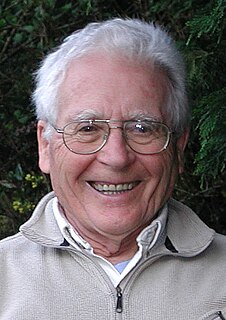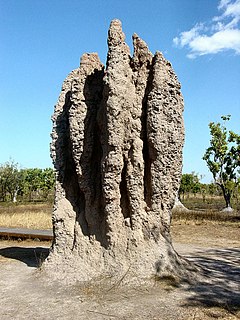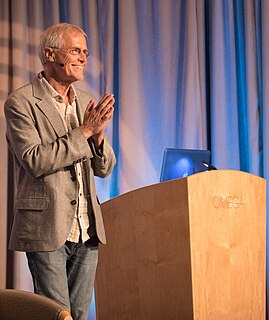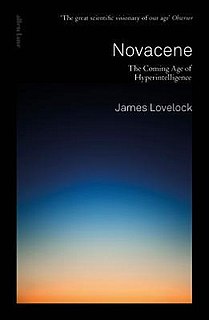Related Research Articles

An extinction event is a widespread and rapid decrease in the biodiversity on Earth. Such an event is identified by a sharp change in the diversity and abundance of multicellular organisms. It occurs when the rate of extinction increases with respect to the rate of speciation. Estimates of the number of major mass extinctions in the last 540 million years range from as few as five to more than twenty. These differences stem from disagreement as to what constitutes a "major" extinction event, and the data chosen to measure past diversity.
Gaia philosophy is a broadly inclusive term for related concepts that living organisms on a planet will affect the nature of their environment in order to make the environment more suitable for life. This set of hypotheses holds that all organisms on a life-giving planet regulate the biosphere in such a way as to promote its habitability. Gaia concept draws a connection between the survivability of a species and its usefulness to the survival of other species.

James Ephraim Lovelock was an English independent scientist, environmentalist and futurist. He is best known for proposing the Gaia hypothesis, which postulates that the Earth functions as a self-regulating system.

Life is a quality that distinguishes matter that has biological processes, such as signaling and self-sustaining processes, from that which does not, and is defined by the capacity for growth, reaction to stimuli, metabolism, energy transformation, and reproduction. Various forms of life exist, such as plants, animals, fungi, protists, archaea, and bacteria. Biology is the science that studies life.
The Mesozoic Era, also called the Age of Reptiles and the Age of Conifers, is the second-to-last era of Earth's geological history, lasting from about 252 to 66 million years ago and comprising the Triassic, Jurassic and Cretaceous Periods. It is characterized by the dominance of archosaurian reptiles, like the dinosaurs; an abundance of conifers and ferns; a hot greenhouse climate; and the tectonic break-up of Pangaea. The Mesozoic is the middle of three eras since complex life evolved: the Paleozoic, the Mesozoic, and the Cenozoic.

The Permian–Triassicextinction event, also known as the End-Permian Extinction and colloquially as the Great Dying, formed the boundary between the Permian and Triassic geologic periods, as well as between the Paleozoic and Mesozoic eras, approximately 251.9 million years ago. It is the Earth's most severe known extinction event, with the extinction of 57% of biological families, 83% of genera, 81% of marine species and 70% of terrestrial vertebrate species. It was the largest known mass extinction of insects.

Lynn Margulis was an American evolutionary biologist, and was the primary modern proponent for the significance of symbiosis in evolution. Historian Jan Sapp has said that "Lynn Margulis's name is as synonymous with symbiosis as Charles Darwin's is with evolution." In particular, Margulis transformed and fundamentally framed current understanding of the evolution of cells with nuclei – an event Ernst Mayr called "perhaps the most important and dramatic event in the history of life" – by proposing it to have been the result of symbiotic mergers of bacteria. Margulis was also the co-developer of the Gaia hypothesis with the British chemist James Lovelock, proposing that the Earth functions as a single self-regulating system, and was the principal defender and promulgator of the five kingdom classification of Robert Whittaker.

SimEarth is a life simulation video game, the second designed by Will Wright, in which the player controls the development of a planet. English scientist James Lovelock served as an advisor and his Gaia hypothesis of planet evolution was incorporated into the game. SimEarth was published in 1990 by Maxis. Versions were made for the Apple Macintosh, Commodore Amiga, IBM PC, SNES, Sega Mega-CD and TurboGrafx-16. It was also subsequently re-released on the Wii Virtual Console. In 1996, several of Maxis' simulation games were re-released under the Maxis Collector Series with greater compatibility with Windows 95 and differing box art, including the addition of Classics beneath the title. SimEarth was re-released in 1997 under the Classics label.

Daisyworld, a computer simulation, is a hypothetical world orbiting a star whose radiant energy is slowly increasing or decreasing. It is meant to mimic important elements of the Earth-Sun system, and was introduced by James Lovelock and Andrew Watson in a paper published in 1983 to illustrate the plausibility of the Gaia hypothesis. In the original 1983 version, Daisyworld is seeded with two varieties of daisy as its only life forms: black daisies and white daisies. White petaled daisies reflect light, while black petaled daisies absorb light. The simulation tracks the two daisy populations and the surface temperature of Daisyworld as the sun's rays grow more powerful. The surface temperature of Daisyworld remains almost constant over a broad range of solar output.

A superorganism or supraorganism is a group of synergetically interacting organisms of the same species. A community of synergetically interacting organisms of different species is called a holobiont.

The Gaia hypothesis, also known as the Gaia theory, Gaia paradigm, or the Gaia principle, proposes that living organisms interact with their inorganic surroundings on Earth to form a synergistic and self-regulating, complex system that helps to maintain and perpetuate the conditions for life on the planet.
In medicine, the hygiene hypothesis states that early childhood exposure to particular microorganisms protects against allergic diseases by contributing to the development of the immune system. In particular, a lack of exposure is thought to lead to defects in the establishment of immune tolerance. The time period for exposure begins in utero and ends at school age.

Paul Gerard Hawken is an American environmentalist, entrepreneur, author, economist, and activist.

The history of Earth concerns the development of planet Earth from its formation to the present day. Nearly all branches of natural science have contributed to understanding of the main events of Earth's past, characterized by constant geological change and biological evolution.

The Red Queen hypothesis is a hypothesis in evolutionary biology proposed in 1973, that species must constantly adapt, evolve, and proliferate in order to survive while pitted against ever-evolving opposing species. The hypothesis was intended to explain the constant (age-independent) extinction probability as observed in the paleontological record caused by co-evolution between competing species; however, it has also been suggested that the Red Queen hypothesis explains the advantage of sexual reproduction at the level of individuals, and the positive correlation between speciation and extinction rates in most higher taxa.

A marine regression is a geological process occurring when areas of submerged seafloor are exposed above the sea level. The opposite event, marine transgression, occurs when flooding from the sea covers previously-exposed land.

Wiser.org, formerly WiserEarth.org, was a user-generated online community space for the social and environmental movement. As one of the social networks for environmental sustainability and social change, Wiser.org was the primary initiative of the non-profit organization WiserEarth, which tracks the work of non-profits around the world. The site mapped and connected non-governmental organizations (NGOs), businesses, governments, groups, and individuals addressing global issues such as climate change, poverty, the environment, peace, water, hunger, social justice, conservation, human rights, and more.
The Medea hypothesis is a term coined by paleontologist Peter Ward for a hypothesis that contests the Gaian hypothesis and proposes that multicellular life, understood as a superorganism, may be self-destructive or suicidal. In this view, microbial-triggered mass extinctions result in returns to the microbial-dominated state it has been for most of its history. The metaphor refers to the mythological Medea, who kills her own children.

Earth system science (ESS) is the application of systems science to the Earth. In particular, it considers interactions and 'feedbacks', through material and energy fluxes, between the Earth's sub-systems' cycles, processes and "spheres"—atmosphere, hydrosphere, cryosphere, geosphere, pedosphere, lithosphere, biosphere, and even the magnetosphere—as well as the impact of human societies on these components. At its broadest scale, Earth system science brings together researchers across both the natural and social sciences, from fields including ecology, economics, geography, geology, glaciology, meteorology, oceanography, climatology, paleontology, sociology, and space science. Like the broader subject of systems science, Earth system science assumes a holistic view of the dynamic interaction between the Earth's spheres and their many constituent subsystems fluxes and processes, the resulting spatial organization and time evolution of these systems, and their variability, stability and instability. Subsets of Earth System science include systems geology and systems ecology, and many aspects of Earth System science are fundamental to the subjects of physical geography and climate science.

Novacene: The Coming Age of Hyperintelligence is a 2019 non-fiction book by scientist and environmentalist James Lovelock. It has been published by Penguin Books/Allen Lane in the UK, and republished by the MIT Press. The book was co-authored by journalist Bryan Appleyard. It predicts that a benevolent eco-friendly artificial superintelligence will someday become the dominant lifeform on the planet and argues humanity is on the brink of a new era: the Novacene.
References
- Citations
- ↑ "International Network for Sustainable Energy". INFORSE. 2015. Retrieved 31 May 2015.
- Bibliography
- Bailey, Ronald (31 July 2002). "Defenders of Earth. Are humans Gaia's immune system?". Reason.com. Retrieved 31 May 2015.
- Lehman, Andy (12 April 2003). "Subtle Psychopathy and Schizophrenic Supermen: Gandhi Was a Cultural Oncologist". New Civilization Network. Retrieved 31 May 2015.
- Hawken, P. (2007). Blessed unrest: How the largest movement in the world came into being and why no one saw it coming. New York: Viking Press. ISBN 9780670038527.
- Lovelock, James (1979). Gaia: A new look at life on Earth. New York: Oxford University Press. ISBN 9780192176653.